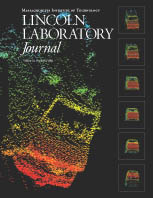Publications
Volume 13, Number 2
 |
|
Classification and Tracking of Moving Ground Vehicles Airborne radars that track moving targets face the challenge of surveillance over large geographic areas where military vehicles are interspersed with civilian traffic. There is a major need to develop robust, efficient, and reliable identification and tracking techniques to identify selected targets, and to maintain tracks for selected critical targets, in dense target environments. Traditionally, tracking and identification have been considered separately; we identify a target first, and then we track it kinematically to sustain the identification. The difficulty with separate identification and tracking is that neither task is sufficient by itself to satisfy the demands of the other. We need to incorporate the distinctive target signature information into the tracker, so that identification and tracking, or signature comparison and tracking, perform together as a unit. The moving-target identification and feature-aided tracking approach described in this article combines kinematic association hypotheses with accumulated target classification information obtained from high range resolution (HRR), inverse synthetic aperture radar (ISAR), and synthetic aperture radar (SAR) signatures, to obtain improved classification and association. We describe the basics of moving-target classification and signature comparison using HRR profiles. In addition, we show improvements in HRR-based target identification using superresolution and Bayesian classification techniques. We describe how this feature information may be incorporated into kinematic tracking. Finally, we discuss methods to improve the robustness of the HRR techniques with the addition of available SAR and ISAR signatures. Toward Operational Space-Based Space Surveillance On 1 October 2000, the Space-Based Visible (SBV) sensor on the Midcourse Space Experiment (MSX) satellite was transitioned to operational status as a Space Surveillance Network (SSN) sensor for the U.S. Air Force. This transition continues a long Lincoln Laboratory history of technology insertion into the nation's space control capability, which started in 1957 with the advent of satellite tracking at the Millstone Hill radar. The transition is an important milestone for the Advanced Concept Technology Demonstration (ACTD) program, which allowed the use of a "residual" experimental/demonstration asset in an operational role directly supporting the warfighter. The information developed during the ACTD was also critical to the definition of and advocacy for a follow-on operational constellation of space-based space-surveillance satellites, which is now planned for funding starting in the 2003 fiscal year. Geiger-Mode Avalanche Photodiodes for Three-Dimensional Imaging We discuss the properties of Geiger-mode avalanche photodiodes (APDs) and their use in developing an imaging laser radar (ladar). This type of photodetector gives a fast electrical pulse in response to the detection of even a single photon, allowing for sub-nsec-precision photon-flight-time measurement. We present ongoing work at Lincoln Laboratory on three-dimensional (3D) imaging with arrays of these diodes, and the integration of the arrays with fast complementary metal-oxide semiconductor (CMOS) digital timing circuits. Three-Dimensional Imaging Laser Radars with Geiger-Mode Avalanche Photodiode Arrays Lincoln Laboratory is developing three-dimensional (3D) imaging laser radars (ladars) that feature few-centimeter range resolution, thousands of pixels, and capture of an entire 3D image on a single laser pulse. The lasers are based on diode-pumped solid-state microchip lasers that are passively Q-switched. The detectors are based on microelectronic arrays of avalanche photodiodes (APD) operating in Geiger (photon counting) mode, with integrated timing circuitry for each pixel. Ladars using these laser and detector technologies offer not only high performance, but also compact packaging. |
|